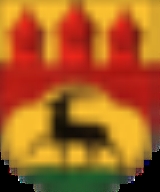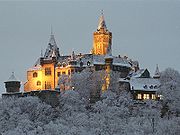
Stolberg-Wernigerode
Encyclopedia
The Principality of Stolberg-Wernigerode was a county
of the Holy Roman Empire
located in the Harz
region around Wernigerode
, now part of Saxony-Anhalt
, Germany
.
had become extinct in 1429 and their lands were inherited through Salic law
by the Counts of Stolberg
, sovereign counts of the Empire since the early 11th century. On 31 May 1645 the Harz line of Stolberg-Stolberg
was divided between a senior Stolberg-Wernigerode line and a junior Stolberg-Stolberg line. Because Wernigerode was heavily damaged by the Thirty Years' War
, the counts of Stolberg-Wernigerode also resided in the castle of Ilsenburg
.
 The town of Gedern
The town of Gedern
in Hesse
, acquired in 1535, became the seat of the cadet branch of Stolberg-Gedern in 1677. This junior line, raised to an imperial principality by Emperor Charles VII of Wittelsbach
in 1742, was reacquired by Stolberg-Wernigerode in 1804. The Wernigerode line also re-acquired Stolberg-Schwarza on 14 September 1748.
In 1714, Count Christian Ernest surrendered his military and the fiscal independence of Stolberg-Wernigerode to King Frederick William I of Prussia
, although he still maintained subordinated rule over his territories as a count. The county was mediatised
in 1807 and made part of the Kingdom of Westphalia
. In the 1815 Congress of Vienna
, Stolberg-Wernigerode was granted to Prussia
, although successive counts retained sovereign rights until 1876. The territory was incorporated into the Prussian Province of Saxony
in 1815.
The Counts of Stolberg-Wernigerode were considered Reichsfrei
. The children of Fürsten, Fürstin and Erbprinzen (Prince and Princess) zu Stolberg-Wernigerode bore the title Prince(ss) zu Stolberg-Wernigerode and were styled
Serene Highness
. Other members of this line bore the equal title Graf/Gräfin zu Stolberg-Wernigerode (not to confound with ordinary Counts), styled Illustrious Highness
.
County
A county is a jurisdiction of local government in certain modern nations. Historically in mainland Europe, the original French term, comté, and its equivalents in other languages denoted a jurisdiction under the sovereignty of a count A county is a jurisdiction of local government in certain...
of the Holy Roman Empire
Holy Roman Empire
The Holy Roman Empire was a realm that existed from 962 to 1806 in Central Europe.It was ruled by the Holy Roman Emperor. Its character changed during the Middle Ages and the Early Modern period, when the power of the emperor gradually weakened in favour of the princes...
located in the Harz
Harz
The Harz is the highest mountain range in northern Germany and its rugged terrain extends across parts of Lower Saxony, Saxony-Anhalt and Thuringia. The name Harz derives from the Middle High German word Hardt or Hart , latinized as Hercynia. The legendary Brocken is the highest summit in the Harz...
region around Wernigerode
Wernigerode
Wernigerode is a town in the district of Harz, Saxony-Anhalt, Germany. Until 2007, it was the capital of the district of Wernigerode. Its population was 35,500 in 1999....
, now part of Saxony-Anhalt
Saxony-Anhalt
Saxony-Anhalt is a landlocked state of Germany. Its capital is Magdeburg and it is surrounded by the German states of Lower Saxony, Brandenburg, Saxony, and Thuringia.Saxony-Anhalt covers an area of...
, Germany
Germany
Germany , officially the Federal Republic of Germany , is a federal parliamentary republic in Europe. The country consists of 16 states while the capital and largest city is Berlin. Germany covers an area of 357,021 km2 and has a largely temperate seasonal climate...
.
History
The Counts of WernigerodeCounty of Wernigerode
The County of Wernigerode was a county of the Holy Roman Empire, located in the Harzgau region of the former Duchy of Saxony, at the northern foot of the Harz mountain range...
had become extinct in 1429 and their lands were inherited through Salic law
Salic law
Salic law was a body of traditional law codified for governing the Salian Franks in the early Middle Ages during the reign of King Clovis I in the 6th century...
by the Counts of Stolberg
County of Stolberg
The County of Stolberg was a county of the Holy Roman Empire located in the Harz mountain range in present-day Saxony-Anhalt, Germany.The town of Stolberg was probably founded in the 12th century as a mining settlement. The Counts of Stolberg probably derived from a branch of the counts of...
, sovereign counts of the Empire since the early 11th century. On 31 May 1645 the Harz line of Stolberg-Stolberg
Stolberg-Stolberg
Stolberg-Stolberg was a county of the Holy Roman Empire located in the southern Harz region. Its capital was the town of Stolberg, now in Saxony-Anhalt, Germany....
was divided between a senior Stolberg-Wernigerode line and a junior Stolberg-Stolberg line. Because Wernigerode was heavily damaged by the Thirty Years' War
Thirty Years' War
The Thirty Years' War was fought primarily in what is now Germany, and at various points involved most countries in Europe. It was one of the most destructive conflicts in European history....
, the counts of Stolberg-Wernigerode also resided in the castle of Ilsenburg
Ilsenburg
Ilsenburg is a town in the district of Harz, in Saxony-Anhalt in Germany. It is situated under the north foot of the Harz Mountains, at the entrance to the Ilsetal valley of the small Ilse river, a tributary of the Oker, about six north-west of the town of Wernigerode. It received town privileges...
.

Gedern
Gedern is a town in the Wetteraukreis district in Hesse, Germany, and historically belongs to Oberhessen. It is located northeast of Hanau at the foot of the Vogelsberg, once one of the largest inactive volcanoes in Europe.-Neighboring towns:...
in Hesse
Landgraviate of Hesse
The Landgraviate of Hesse was a Landgraviate of the Holy Roman Empire. It existed as a unity from 1264 to 1567, when it was divided between the sons of Philip I, Landgrave of Hesse.-History:...
, acquired in 1535, became the seat of the cadet branch of Stolberg-Gedern in 1677. This junior line, raised to an imperial principality by Emperor Charles VII of Wittelsbach
Charles VII, Holy Roman Emperor
Charles VII Albert a member of the Wittelsbach family, was Prince-elector of Bavaria from 1726 and Holy Roman Emperor from 24 January 1742 until his death in 1745...
in 1742, was reacquired by Stolberg-Wernigerode in 1804. The Wernigerode line also re-acquired Stolberg-Schwarza on 14 September 1748.
In 1714, Count Christian Ernest surrendered his military and the fiscal independence of Stolberg-Wernigerode to King Frederick William I of Prussia
Frederick William I of Prussia
Frederick William I of the House of Hohenzollern, was the King in Prussia and Elector of Brandenburg from 1713 until his death...
, although he still maintained subordinated rule over his territories as a count. The county was mediatised
German Mediatisation
The German Mediatisation was the series of mediatisations and secularisations that occurred in Germany between 1795 and 1814, during the latter part of the era of the French Revolution and then the Napoleonic Era....
in 1807 and made part of the Kingdom of Westphalia
Kingdom of Westphalia
The Kingdom of Westphalia was a new country of 2.6 million Germans that existed from 1807-1813. It included of territory in Hesse and other parts of present-day Germany. While formally independent, it was a vassal state of the First French Empire, ruled by Napoleon's brother Jérôme Bonaparte...
. In the 1815 Congress of Vienna
Congress of Vienna
The Congress of Vienna was a conference of ambassadors of European states chaired by Klemens Wenzel von Metternich, and held in Vienna from September, 1814 to June, 1815. The objective of the Congress was to settle the many issues arising from the French Revolutionary Wars, the Napoleonic Wars,...
, Stolberg-Wernigerode was granted to Prussia
Kingdom of Prussia
The Kingdom of Prussia was a German kingdom from 1701 to 1918. Until the defeat of Germany in World War I, it comprised almost two-thirds of the area of the German Empire...
, although successive counts retained sovereign rights until 1876. The territory was incorporated into the Prussian Province of Saxony
Province of Saxony
The Province of Saxony was a province of the Kingdom of Prussia and later the Free State of Prussia from 1816 until 1945. Its capital was Magdeburg.-History:The province was created in 1816 out of the following territories:...
in 1815.
The Counts of Stolberg-Wernigerode were considered Reichsfrei
Reichsfreiheit
Imperial immediacy was a privileged feudal and political status, which the estates of the realm such as an imperial city, a religious entity, a feudal principality, or a minor lordship could attain within the Holy Roman Empire...
. The children of Fürsten, Fürstin and Erbprinzen (Prince and Princess) zu Stolberg-Wernigerode bore the title Prince(ss) zu Stolberg-Wernigerode and were styled
Style (manner of address)
A style of office, or honorific, is a legal, official, or recognized title. A style, by tradition or law, precedes a reference to a person who holds a post or political office, and is sometimes used to refer to the office itself. An honorific can also be awarded to an individual in a personal...
Serene Highness
Serene Highness
His/Her Serene Highness is a style used today by the reigning families of Liechtenstein and Monaco. It also preceded the princely titles of members of some German ruling and mediatised dynasties as well as some non-ruling but princely German noble families until 1918...
. Other members of this line bore the equal title Graf/Gräfin zu Stolberg-Wernigerode (not to confound with ordinary Counts), styled Illustrious Highness
Illustrious Highness
His/Her Illustrious Highness is the English-language form for a style used by various members of the European aristocracy....
.
Counts of Stolberg-Wernigerode
- Henry Ernest 1645-1672
- Ernest, son 1672-1710
- Christian ErnestChristian Ernest of Stolberg-WernigerodeCount Christian Ernest of Stolberg-Wernigerode was a German politician. He ruled the County of Wernigerode in the Harz mountains, which in 1714 became a dependency of Brandenburg-Prussia, from 1710 to 1771.- Life :Christian Ernest was the tenth child from the second marriage of Count Ludwig...
, nephew 1710-1771 - Henry ErnestHenry Ernest of Stolberg-WernigerodeHenry Ernest of Stolberg-Wernigerode was a German politician, canon, dean and author of many hymns. He also published some poetry and collections of songs. He was Count of Stolberg-Wernigerode from 1771 until his death.- Life :...
, son 1771-1778 - Christian FrederickChristian Frederick of Stolberg-WernigerodeCount Friedrich Christian of Stolberg-Wernigerode succeeded his father as ruler of the County of Wernigerode in 1778.- Life :Count Christian Frederick was the only son of Count Henry Ernest of Stolberg-Wernigerode and Princess Anna of Anhalt-Köthen. He was a member of the noble family...
, son 1778-1824 - HenryHenry of Stolberg-WernigerodeCount Henry of Stolberg-Wernigerode succeeded his father in 1824 as ruler of the County of Wernigerode.- Life :...
, son 1824-1854 - Otto, grandson, 1854–1896, German Vice-Chancellor of GermanyVice-Chancellor of GermanyThe Vice-Chancellor of Germany is, according to protocol, the second highest position in the Cabinet of GermanyIn case of the Chancellor's absence, the vice-chancellor acts in his or her place, for instance by heading cabinet meetings...
, Prince fom 1890

